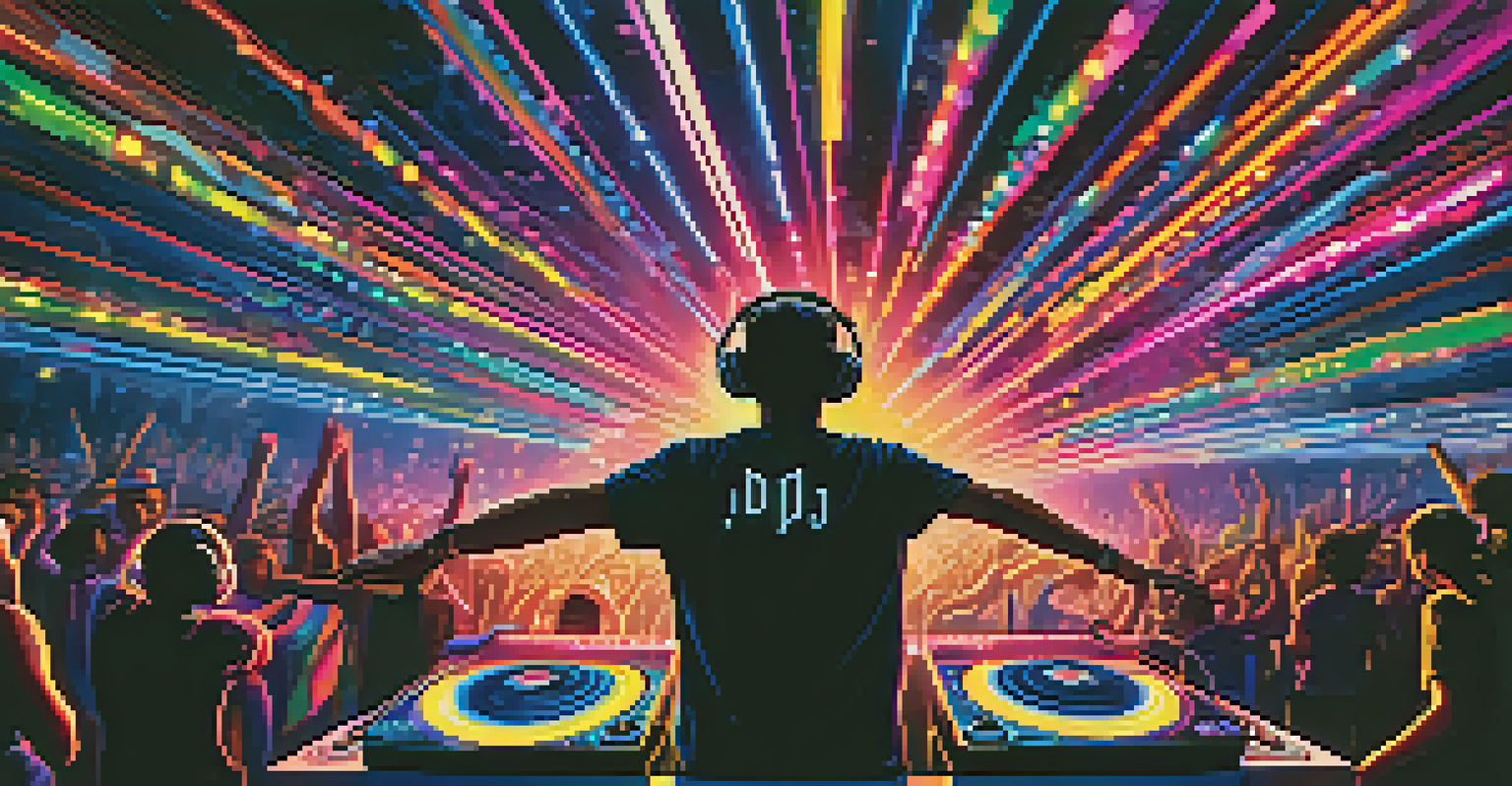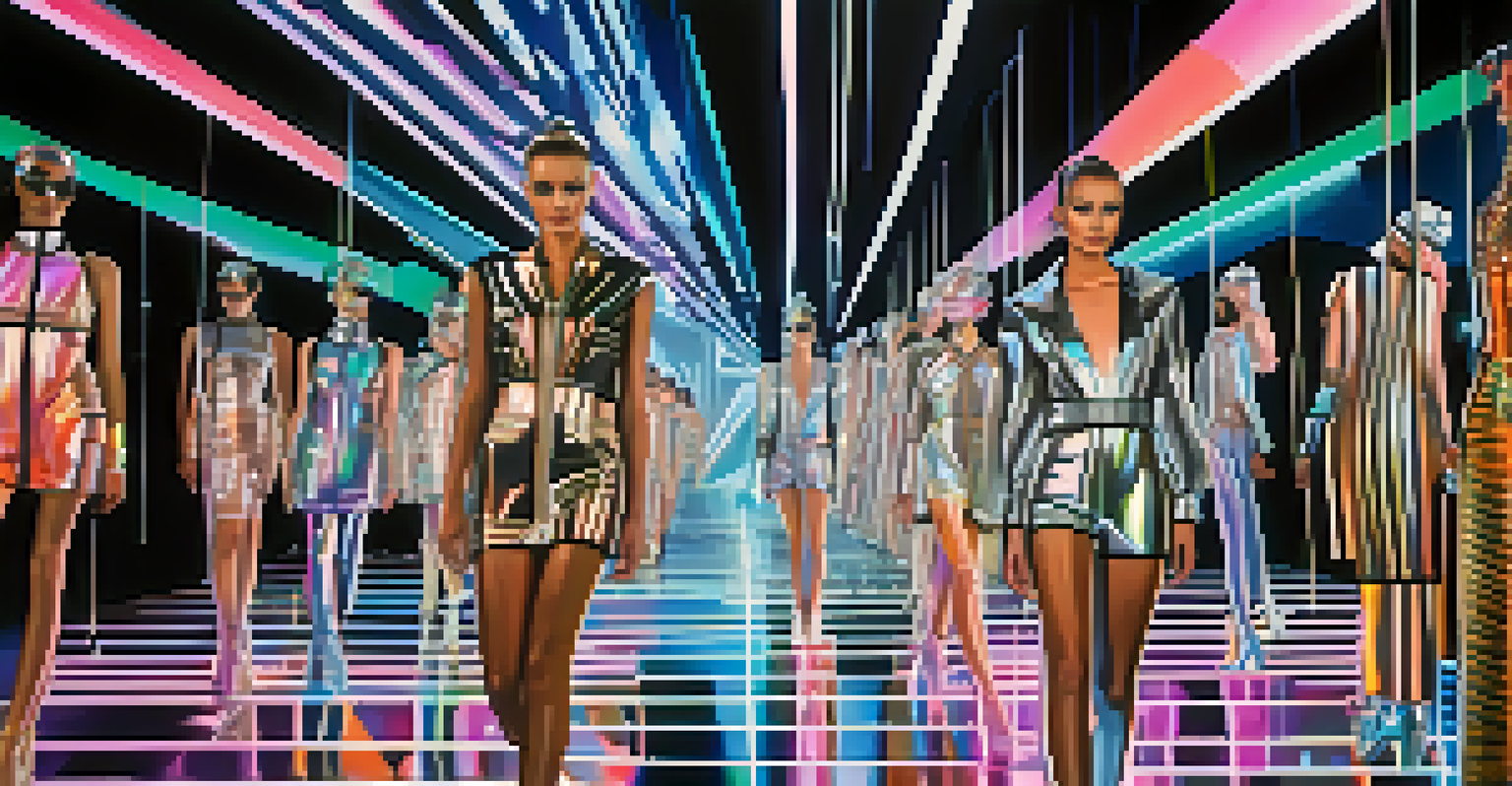The Rise of Electronic Music and Its Impact on Modern Fashion

The Birth of Electronic Music: A Cultural Revolution
Electronic music emerged in the mid-20th century, revolutionizing the soundscape of modern music. Pioneers like Kraftwerk and Brian Eno experimented with synthesizers and tape loops, creating a genre that was both innovative and polarizing. This new sound not only influenced music but also became a cultural touchstone for a generation seeking change and liberation.
Music is the shorthand of emotion.
As electronic music gained popularity, it began to intersect with various art forms, including fashion. Iconic festivals like Woodstock and later, the rise of raves, became platforms for self-expression and new fashion trends. The vibrant, eclectic styles that emerged reflected the experimental nature of electronic music, emphasizing individuality and creativity.
This cultural revolution set the stage for a symbiotic relationship between music and fashion, where each influenced the other. As electronic music evolved, so did the visual aesthetics associated with it, paving the way for a dynamic interplay that continues to shape modern culture.
The 1980s: Synths, Style, and Pop Culture
The 1980s marked a significant turning point for electronic music, with the advent of accessible synthesizers and drum machines. Artists like Depeche Mode and New Order not only dominated the charts but also brought a unique style that defined the era. Their fashion choices—think leather jackets, skinny ties, and bold colors—became emblematic of the electronic music scene.

The MTV generation amplified this relationship, showcasing music videos that blended sound and visual aesthetics in unprecedented ways. Fashion designers began to draw inspiration from the vibrant, avant-garde looks of electronic artists, leading to iconic trends like the power suit and punk-inspired ensembles. This cross-pollination of music and fashion created a cultural phenomenon that resonated with youth across the globe.
Electronic Music's Cultural Impact
Electronic music has transcended its sonic roots to shape fashion and cultural identity across generations.
As electronic music gained mainstream acceptance, its influence reached fashion runways and streetwear alike. The bold, experimental styles of the 80s laid the groundwork for future generations of artists and designers, solidifying a lasting impact on both industries.
The 1990s: Rave Culture and Fashion Statements
The 1990s ushered in the rave culture, where electronic music took on a new, euphoric dimension. This underground movement was characterized by all-night dance parties and a DIY ethos, reflected in the vibrant, eclectic fashion of the time. Neon colors, oversized clothing, and playful accessories became symbols of the freedom and joy associated with rave culture.
Fashion is the armor to survive the reality of everyday life.
Rave fashion was about more than just style; it was a statement of identity and community. Many attendees expressed themselves through unique outfits, often incorporating elements like glow sticks, face paint, and handmade accessories. This emphasis on individuality resonated with the ethos of electronic music, which celebrated diversity and self-expression.
As rave culture gained traction, it began to influence mainstream fashion designers as well. Collections featuring bright colors, playful patterns, and streetwear aesthetics emerged, showcasing the powerful connection between electronic music and modern fashion.
The 2000s: EDM and High Fashion Fusion
As electronic dance music (EDM) exploded in popularity during the 2000s, it also caught the attention of high-fashion designers. Festivals like Coachella became hotspots for fashion influencers, where attendees showcased bold, statement-making outfits that blended street style with high-end fashion. This fusion reflected the growing acceptance of electronic music in mainstream culture.
Designers began collaborating with artists, resulting in collections that merged music and fashion in innovative ways. Iconic figures like Lady Gaga and Calvin Harris not only dominated the charts but also became fashion icons, influencing trends and pushing boundaries. Their unique styles often incorporated elements of electronic music, further blurring the lines between the two industries.
Fashion Evolution in the EDM Scene
The fusion of electronic dance music and high fashion has redefined style norms, making bold statements on global runways.
This era marked a turning point where electronic music was no longer just a subculture but a significant influence on global fashion trends. As the lines continued to blur, the partnership between electronic music and high fashion grew deeper, shaping the aesthetic landscape of the 21st century.
Fashion Icons of Electronic Music: Influencers and Trends
Today, numerous artists in the electronic music scene have become fashion icons, influencing trends on and off the stage. Figures like Dua Lipa, Grimes, and Marshmello not only captivate audiences with their music but also make bold fashion statements that resonate with fans. Their unique styles often reflect the eclectic nature of electronic music, embracing everything from avant-garde pieces to nostalgic throwbacks.
Social media has amplified this influence, with artists sharing their fashion choices directly with fans. Platforms like Instagram and TikTok allow for real-time trendsetting, where followers can replicate the looks of their favorite artists. This accessibility has created a dynamic where music and fashion continually inspire and evolve together.
Moreover, collaborations between musicians and designers are more prevalent than ever, resulting in limited-edition collections that celebrate the fusion of art forms. These partnerships not only elevate the visibility of electronic music but also solidify its place in the fashion world, creating a vibrant dialogue between sound and style.
Sustainability in Electronic Music Fashion
As the fashion industry faces increasing scrutiny over sustainability, the electronic music scene is also adapting. Many artists and designers are now prioritizing eco-friendly materials and ethical production processes in their fashion choices. This shift reflects a growing awareness of the environmental impact of both music festivals and fashion.
At music festivals, initiatives promoting sustainability are becoming more common. From eco-conscious merchandise to recycling programs, the electronic music community is embracing a greener approach. Artists are using their platforms to advocate for sustainable practices, encouraging fans to make conscious fashion choices.
Sustainability in Music Fashion
The electronic music community is increasingly prioritizing sustainability, advocating for eco-friendly practices within fashion.
This emphasis on sustainability is not just a trend; it's a movement that resonates with the values of many electronic music fans. As the industry evolves, the intersection of electronic music and fashion is increasingly focused on creating a positive impact, ensuring that both remain relevant in a rapidly changing world.
The Future of Electronic Music and Fashion: A Collaborative Journey
Looking ahead, the relationship between electronic music and fashion is set to evolve even further. As technology advances, the possibilities for innovative fashion experiences will expand, with virtual reality and augmented reality playing significant roles. Imagine immersive fashion shows set to live electronic music, creating a multi-sensory experience that blurs the lines between the two worlds.
Moreover, the rise of digital fashion and NFTs is opening new avenues for artists and designers to collaborate. Virtual clothing and accessories can be worn in digital spaces, allowing fans to express their love for electronic music in entirely new ways. This fusion of technology and creativity is set to redefine how we perceive fashion and identity in the digital age.

Ultimately, the future of electronic music and fashion is a collaborative journey, where creativity knows no bounds. As both industries continue to influence and inspire each other, we can expect to see even more exciting developments that reflect the spirit of innovation and self-expression inherent in electronic music.